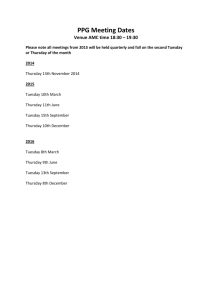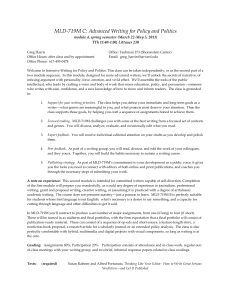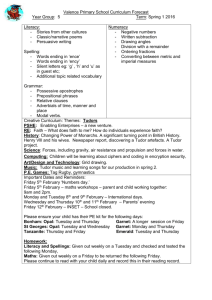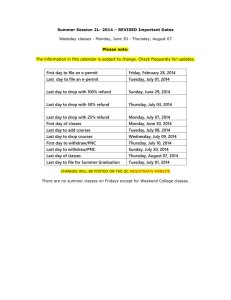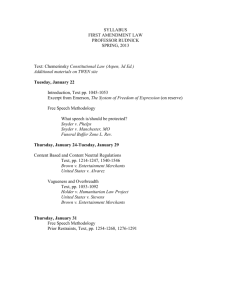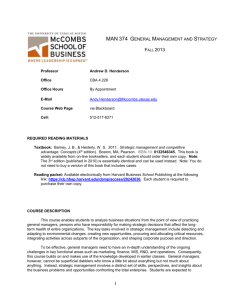BA 388T - Strategic Management
advertisement
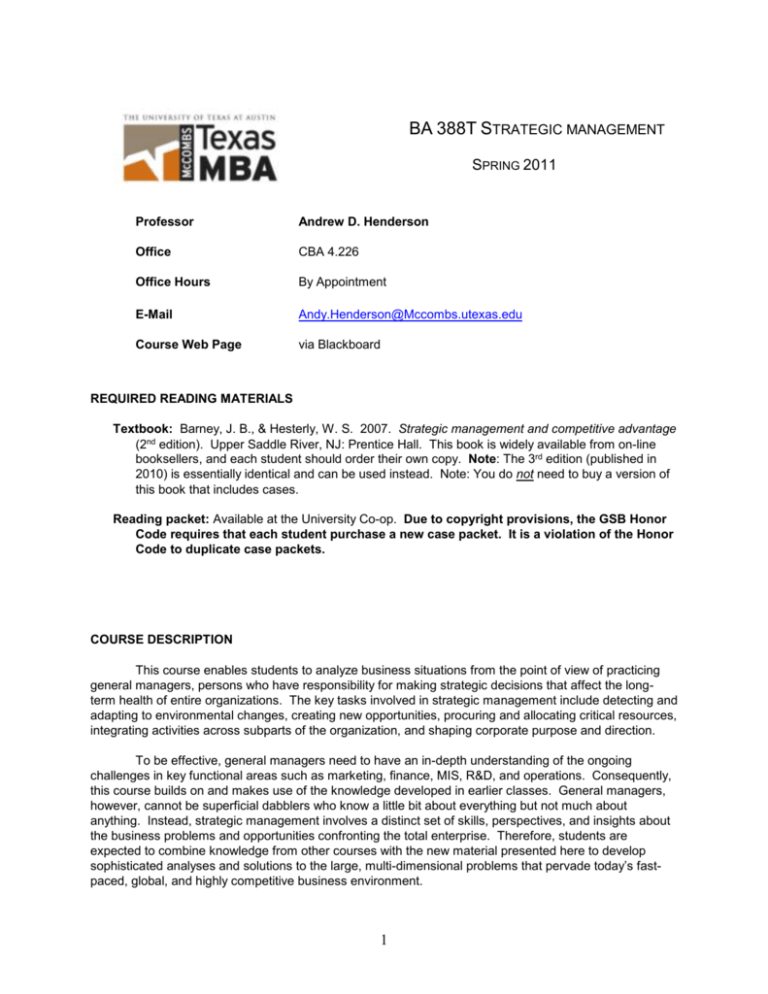
BA 388T STRATEGIC MANAGEMENT SPRING 2011 Professor Andrew D. Henderson Office CBA 4.226 Office Hours By Appointment E-Mail Andy.Henderson@Mccombs.utexas.edu Course Web Page via Blackboard REQUIRED READING MATERIALS Textbook: Barney, J. B., & Hesterly, W. S. 2007. Strategic management and competitive advantage (2nd edition). Upper Saddle River, NJ: Prentice Hall. This book is widely available from on-line booksellers, and each student should order their own copy. Note: The 3rd edition (published in 2010) is essentially identical and can be used instead. Note: You do not need to buy a version of this book that includes cases. Reading packet: Available at the University Co-op. Due to copyright provisions, the GSB Honor Code requires that each student purchase a new case packet. It is a violation of the Honor Code to duplicate case packets. COURSE DESCRIPTION This course enables students to analyze business situations from the point of view of practicing general managers, persons who have responsibility for making strategic decisions that affect the longterm health of entire organizations. The key tasks involved in strategic management include detecting and adapting to environmental changes, creating new opportunities, procuring and allocating critical resources, integrating activities across subparts of the organization, and shaping corporate purpose and direction. To be effective, general managers need to have an in-depth understanding of the ongoing challenges in key functional areas such as marketing, finance, MIS, R&D, and operations. Consequently, this course builds on and makes use of the knowledge developed in earlier classes. General managers, however, cannot be superficial dabblers who know a little bit about everything but not much about anything. Instead, strategic management involves a distinct set of skills, perspectives, and insights about the business problems and opportunities confronting the total enterprise. Therefore, students are expected to combine knowledge from other courses with the new material presented here to develop sophisticated analyses and solutions to the large, multi-dimensional problems that pervade today’s fastpaced, global, and highly competitive business environment. 1 While not all students will become general managers, for several reasons this course should benefit virtually all who take it. First, ongoing trends in the corporate world towards flatter, less hierarchical organizations have resulted in strategic decisions being made at ever lower hierarchical levels, often by relatively inexperienced people. Second, a number of factors, including technological change and the continuing shift to global markets, have forced established firms to become increasingly innovative and entrepreneurial, and such initiatives often originate at lower organizational ranks. Third, functional specialists such as professionals in finance and marketing are the people on whom general managers rely to implement a firm’s existing strategy and collect the information needed to update and revise it. Since functional managers are often under intense pressure to fix problems in their own areas without regard to the overall business, it is critical that they develop a keen awareness and appreciation of the challenges facing the firm as a whole. Verbal communication is both vital to and inseparable from strategic management. This has two critical implications for this class. First, there will be relatively few lectures. We will instead emphasize case analysis and discussion because strategy is best learned by immersion in actual business situations where one can fully appreciate the inherent conflicts, pressures, uncertainties, and risks that general management entails. Second, a case-based approach necessitates learning by doing, so your active participation is integral to your knowledge development in this course. PERFORMANCE MEASURES AND FEEDBACK Components and Weighting Your grade will be based on z-scores of three components, weighted as follows: Class contribution (individual) Mid-term case analysis (4-person groups) Final case analysis (2-person groups) *30% 30% 40% 100% The historical distribution of grades has been roughly as follows: 35% As, 10% below B, remainder Bs. Plus/Minus grading applies to this course. Class Contribution The essence of strategic management is a willingness to make decisions on the basis of imperfect and limited data, and despite great risk and uncertainty, to have the courage and boldness to carry out proposed actions. In the end, goals, targets, and ideas must be converted into actions, which requires convincing others. Consequently, the classroom should be a considered a laboratory where you can test your ability to convince your peers of the value of your ideas. Clearly, you must participate in class if you are going to share your ideas with others, so you should make a habit of doing so. Yet there is no need to speak in every session. Some of the best contributors participate less often than the most active speakers. Though less vocal, their thoughts are truly insightful and persuasive. Quality is more important than sheer quantity. At the start of a typical session, two students will be asked to open the class by answering a specific question or discussing a specific issue. Case preparation, which includes careful thought about 2 the assignment questions and the associated readings, should be sufficient to handle such lead-off responsibilities. After a few minutes of initial analysis, we will then open the discussion to the rest of the class. While there are many ways to effectively prepare for class, every student is responsible for having a plan of action for the case protagonist, be it an individual or an entire organization. Action plans answer three questions: (1) What’s going on?; (2) What do we do next?; and (3) How do we make it happen? Toward the end of some classes, I will ask two students to close the session by listing the bottomline lessons that should be derived from the day’s case, readings, and in-class discussion. After the selected students report their conclusions, other students may then comment and possibly modify the list. In assessing your class contributions, I ask myself the following questions: a. Is this person an excellent listener? b. Are the points made relevant to the discussion and linked to the comments of others? c. Do the comments incorporate concepts we have covered in class and in the readings? You may not agree with the all concepts introduced in a particular reading, but you should be able to apply those concepts to our case discussions, and if you see a need, critique them from an informed, data-driven perspective. d. Do the comments add value and new insight, or are they simple recitations of case facts? e. Do the comments improve our understanding by clarifying and highlighting the important aspects of earlier remarks? f. Does the participant distinguish among different kinds of data – facts, opinions, personal beliefs, theoretical concepts, etc.? g. Is there a willingness to test new ideas, or are all comments safe? Example: seconding or repeating earlier comments without elaboration. h. Does this person raise great questions that appropriately expand the scope of our conversation or help us cut to the heart of the matter. Mid-Term Case Analysis The mid-term involves a written case analysis that you will do as a member of a 4-5 person team. A detailed assignment and the exam case itself will be distributed approximately one week before it is due. The textual body of your analysis should not exceed 7 double-spaced typewritten pages. Use 1-inch margins and a 12-point font. I will read only the first 7 pages, so please stay within assigned limits. In addition, you must provide a 1 page, double-spaced executive summary. Also, you may include up to 3 additional 1-page exhibits with charts, tables, or figures. Exhibits that are not directly referenced, in order, in the main text will not be read. There should be only 1 exhibit per page. Except in extreme emergencies, late cases will not be accepted. Do not place your names on your analysis. Instead, write or type names on the back of the last page. You may not discuss the case itself or your write-up with anyone other than your team until after all exams have been turned in. The exam is due at noon on March 3. Note: If you are a second year student who is retaking BA 388T, then you must work by yourself on both the mid-term and final. 3 Final Case Analysis The final involves a written case analysis that you will do with a partner. Your partner must not be someone who was in your mid-term group. A detailed assignment and the exam case itself will be distributed during the last week of class. Your write-up will be due during the final exam period. All of the material covered in the course is fair game, but a good deal of emphasis will be given to the topics covered in Modules 3 and 4. Real-Time Events You should make a habit of reading business periodicals such as Business Week, the Financial Times, and The Economist. Keeping abreast of current business developments will facilitate your participation in class discussions. It will also enable you to make good suggestions for our real-time case discussion on March 1. In addition, if you are interested in delving further into the topics that we discuss, I strongly recommend that you read the following books. Ariely, D. 2009 Predictably irrational: The hidden forces that shape our decisions New York: HarperCollins Beinhocker, E. D. 2007 The Origin of Wealth: Evolution, complexity and the radical remaking of economics Boston, Massachusetts: Harvard Business School Press Ghemawat, Pankaj Redefining Global Strategy Harvard Business School Press Kidder, T. 1981 The soul of a new machine New York: Avon Lewis, M. 2003 Moneyball New York: Norton Miller, D. and Le Breton-Miller, I. 2005 Managing for the long run Boston, Massachusetts: Harvard Business School Press Pfeffer, J. and Sutton, R. 2006 Hard facts, dangerous half truths & total nonsense Boston, Massachusetts: Harvard Business School Press Schroeder, A. 2008 The snowball New York: Bantam-Dell 4 Other Points Please note the following: a. In determining final grades, class contribution is given particular emphasis in settling borderline cases. b. You are strongly encouraged to form study groups and brain-storm about cases and reading assignments. c. If you miss class, you are responsible for informing me beforehand and obtaining any notes, handouts, additional reading materials, or assignment changes from your classmates. d. Learning by doing is a critical feature of this course, and you deprive yourself and others of that opportunity if you discuss cases with students who have taken BA 388T in the past or in another section during the current semester. Therefore, it is an honor code violation to send or receive any communications about what happened in another section prior to our discussion of a particular case. No talking (verbal, electronic or otherwise) or sharing notes across sections until after a focal case is finished. e. Per Management Department policy, laptop computers are not allowed. They must be turned off and closed when class begins, as must cell phones and all other electronic devices. Accommodations will be made for students with disabilities. (See point g below.) f. Each student is responsible for any assignment changes that arise throughout the semester. g. The University of Texas at Austin provides upon request appropriate academic accommodations for qualified students with disabilities. For more information, contact the Office of the Dean of Students at 471-6259, 471-6441 TTY. 5 COURSE TOPICS AND ASSIGNMENTS MODULE 1: THE ROLE OF THE GENERAL MANAGER Session 1 Tuesday, Jan. 18 Reading: Mintzberg, H. “The manager’s job: Folklore and fact”. Harvard Business Review, [90210] Reading: Barney & Hesterly, Chapter 1, “What is strategy and the Strategic Management Process”. Reading: "Why We Use the Case Method," Appendix, Course Syllabus Session 2 Thursday, Jan 20 Case: Cola Wars Continue: Coke and Pepsi in 2006 [9-706-447] Reading: Barney & Hesterly, Chapter 2, “Evaluating a Firm’s External Environment”, pp. 3056. Focus questions: (1) Why is the soft drink industry so profitable? (2) How has the competition between Coke and Pepsi affected the industry’s profits? (3) Why is the profitability so different between the concentrate business and the bottling business? (4) Can Coke and Pepsi sustain their profits in the wake of flattening demand and the growing popularity of non-carbonated soft drinks? 6 MODULE 2: BUSINESS-LEVEL STRATEGY Session 3 Tuesday, Jan 25 Case: Cola Wars Continue (cont.) Readings: Barney & Hesterly, Chapter 5, “Product Differentiation” Today, we’ll continue our discussion of industry structure and competition. Session 4 Thursday, Jan. 27 Case: Adolph Coors in the Brewing Industry. [9-388-014] Although this is an older case, it deals with several timeless challenges facing general managers, including the need to defend a company’s competitive advantage. I will provide post-case information to bring us up to date. Readings: Barney & Hesterly, Chapter 4, “Cost Leadership” Barney & Hesterly, Chapter 6, “Vertical Integration” Focus questions: (1) Why was Coors so successful prior to 1978? (2) How has Coors performed since 1978? What explains this change? (3) Given the situation at the end of the case, what actions should Coors’ management take? 7 Session 5 Tuesday, Feb. 1 Case: Edward Jones in 2006: Confronting success. [9-707-497] Retail Financial Services in 1998 (skim for major trends) [799051] Reading: Hambrick, D. C. and Fredrickson, J. “Are You Sure You Have a Strategy?” Academy of Management Executive, November, 2001. Focus questions: (1) Using Hambrick and Fredrickson’s Strategy Diamond framework, what is Edward Jones’ strategy as of 2006? Which elements of the strategy represent recent changes? (2) Pay particular attention to the “Economic Logic” of the strategy. Why does the company have such a high return on equity (ROE)? Can you think of other instances in which a relatively low-share player in an industry is significantly more profitable than some (or all) of the higher-share players? (3) What recommendations would you make to Mr. Weddle? Session 6 Thursday, Feb. 3 Case: Nintendo’s disruptive strategy: Implications for the video game industry [HKU814] Reading: Bower, J. L., & Christensen, C. M. 1995. Disruptive technologies: Catching the wave. Harvard Business Review, Jan. – Feb. [95103] Focus questions: (1) How has the video game industry evolved, particularly in terms of competition and technology? (2) What are the key elements of Nintendo’s strategy, and why has it been successful? (3) What strategies and options are available to Nintendo’s competitors? 8 Session 7 Tuesday, Feb. 8 Case: Nintendo’s disruptive strategy (cont.) Reading: Fleming, L. “Breakthroughs and the ‘Long Tail’ of Innovation”, Sloan Management Review [SMR 265] Tushman, M. L., & O’Reilly, C. A. O. “The tyranny of success: Managing for today and tomorrow”. [2427BC] In this session, we will continue our discussion of the Nintendo case and address more broadly the effects of innovation and technological change. Focus questions: (1) How do established firms typically respond when confronted with new technologies? (2) Thinking beyond the Nintendo case, what are three firms that have dealt successfully with technological change? What are three firms that have not dealt successfully with such change? What are the reasons for their differing outcomes? Note: Today, I will collect your votes for the company and real-time strategy issue that we will discuss in class on March 1. Session 8 Thursday, Feb. 10 Case: Wal-Mart Stores in 2003. [9-704-430] Reading: Hamel, G. and Prahalad, C. K. “Strategy as Stretch and Leverage”, Harvard Business Review. [93204] Focus questions: (1) What, historically, has been Wal-Mart’s key source of competitive advantage in discount retailing? (2) How sustainable is Wal-Mart’s competitive advantage in discount retailing? (3) Evaluate their diversification into the food industry. 9 Session 9 Tuesday, Feb. 15 Case: Wal-Mart, 2007 [9-707-517] Reading: Prahalad, C. K., and Hamel, G. “The Core Competence of the Corporation”, Harvard Business Review. [90311] Reading: Barney & Hesterly, Chapter 3, “Evaluating a Firm’s Internal Capabilities” (This is an update to the case used last session.) (1) How transferable are Wal-Mart’s historical advantages, particularly as it moves into new formats, new international locations, and new service offerings? (2) What are the major differences between the Resource-Based View and Porter’s five forces model? What are the strengths and weaknesses of each model? Session 10 Thursday, Feb. 17 Case: Gillette’s Launch of Sensor. [9-792-028] Reading: Barney & Hesterly, Chapter 2, “Evaluating a Firm’s External Environment”, pp. 5766. Focus questions: (1) Should Sensor be launched as a cartridge or disposable razor? How do industry trends affect this decision? (2) How much advertising should be used to launch Sensor? $10 million? $20 million? (3) What should be the schedule for launching Sensor? How should schedules vary around the world (Europe, U.S., Japan, etc.)? 10 Session 11 Tuesday, Feb. 22 Case: Gillette’s Launch of Sensor. (cont.) Reading: Introduction, D’Aveni, R. A. (1994), in Hypercompetition: Managing the dynamics of strategic maneuvering, New York: Free Press, pp. 1-36. Today, we will continue our discussion of Gillette’s launch of the Sensor product. Session 12 Thursday, Feb. 24 Case: Ducati [9-701-132] Reading: Ghemawat, P., & Rivkin, J. W. “Creating Competitive Advantage”, Harvard Business School note [9-798-062] Focus questions: (1) How did Ducati become the second most profitable motorcycle maker in the world despite it small scale? (2) Can Ducati sustain its position in the sport segment? Can Honda and the other Japanese manufacturers stop its growth in this segment? (3) What strategic alternatives are available to Minoli in 2001? (4) Which alternative would you recommend? Why? 11 Session 13 Tuesday, Mar. 1 This session will be devoted to discussion of the company and real-time strategy issue selected by the class. Session 14 Thursday, Mar. 3 No class today. Your mid-term write up is due at noon. Please place your write up in the “Henderson” in-box on the bookcase outside the Management Department office, CBA 4.202. 12 Session 15 Tuesday, Mar. 8 (Global Trip Period) Readings: TBD Session 16 Thursday, Mar. 10 (Global Trip Period) Readings: TBD **** Spring Break: Mar. 14– Mar. 20 … Enjoy! **** 13 MODULE 3: CORPORATE-LEVEL STRATEGY Session 17 Tuesday, Mar. 22 Case: Cisco Systems, Inc.: Acquisition Integration for Manufacturing (A). [9-600-015] Reading: Barney & Hesterly, Chapter 10, “Mergers and Acquisitions” Reading: P. C. Haspeslagh & Jemison, D. B. “Acquisitions – Myths and reality”, Sloan Management Review, Winter 1987, pp. 53-58. Focus questions: (1) What allows Cisco to be successful in its strategy? (2) What role do acquisitions play at Cisco? (3) What are your observations about the acquisition process at Cisco? (4) What might go wrong with Cisco’s strategy? Session 18 Thursday, Mar. 24 Case: Cisco Systems, Inc. (cont.) Reading: Barney & Hesterly, Chapter 7, “Corporate Diversification”. Reading: Chamber, J., Fryer, B., & Stewart, T. A. “Cisco sees the future.” [R0811D] Harvard Business Review. Today, we will continue our discussion of Cisco and acquisitions as a means of diversifying. 14 Session 19 Tuesday, Mar. 29 Case: M-Tronics (A) [9-807-156] Reading: O’Reilly, C., and Tushman, M. “The Ambidextrous Organization”, Harvard Business Review. [R0404D] Focus questions: (1) What is troubling George McElroy? (2) Should Mr. Martell be concerned about same issues? (3) What actions should Mr. Martell take at this time? Please be as specific as possible. Session 20 Thursday, Mar. 31 Case: Vivendi: Revitalizing a French Conglomerate [9-799-019] Reading: Goold, M. and Campbell, A. “Desperately Seeking Synergy”, Harvard Business Review. [98504] Reading: Bower, J. L. “Not All M&As are Alike – And That Matters”, Harvard Business Review. [R0103F] Focus questions: (1) What is Vivendi’s corporate vision? How does this firm intend to create value? (2) Is this a good approach for the company? Is this a good approach for the investor? (3) How does the business environment in France affect Messier’s plans and his ability to carry them out? 15 Session 21 Tuesday, Apr. 5 Case: UTV and Disney: A strategic alliance [910M43] Reading: Huston, L. and Sakkab, N. 2006. “Connect and Develop: Inside Procter & Gamble's New Model for Innovation”, Harvard Business Review. [R0603C] Focus questions: (1) What role should strategic alliances play in the growth of UTV? (2) What are the global opportunities for UTV How could an alliance with Disney give UTV an edge in it international operations? (3) What are the advantages and disadvantages of a strategic alliance with Disney? What would be a viable alternative to an alliance, given the revenue targets proposed by Ronnie Screwvala? (4) Should UTV do an all-out global expansion, or should it solidify its domestic business and expand primarily in India? 16 MODULE 4: STRATEGY IMPLEMENTATION Session 22 Thursday, Apr. 7 Case: IBM’s decade of transformation: Turnaround to growth. [9-805-130] Reading: Galbraith, J. R. (1995). Chapters 2-3 in Designing organizations: An executive briefing on strategy structure, and process, San Francisco, CA: Jossey-Bass, pp. 11-39. Focus questions: (1) Why do large companies like IBM find it so difficult to create new businesses? What are the primary barriers to success? (2) What did Gerstner do when he assumed the role of CEO in April 1993? Evaluate his approach to crisis management. How well did he perform as a turnaround manager? (3) Can a company like IBM be organized for both innovation and efficient operation? 17 Session 23 Tuesday, Apr. 12 Case: Cleveland Twist Drill (A) Reading: Gabarro, J. J. “When a new manager takes charge”, Harvard Business Review. [Reprint 95204] Harrigan, K., & Porter, M.E. “End-Game Strategies for Declining Industries”, Harvard Business Review. [Reprint 83409] Focus questions: (1) What are the major problems facing Jim Bartlett at Cleveland Twist Drill? How serious is the situation? (2) As Bartlett, what is your detailed plan of action for accomplishing the objectives that you and Ames have for the business? (3) Which of the three options that Bartlett was considering in April 1982 would you pursue? Why? Are there others that make more sense given his objectives? Session 24 Thursday, Apr. 14 Case: Cleveland Twist Drill (B) [9-384-163] (Not in the course packet. I will distribute the B case at the end of the previous session.) Reading: Quinn, J. B. “Strategic Change: ‘Logical Incrementalism’,” Sloan Management Review, Summer 1989. In this session, we will continue our discussion of strategy implementation by considering the events subsequent to those discussed in the prior class. Our intent is to clarify and gain further understanding of the issues raised. 18 Session 25 Tuesday, Apr. 19 Case: Southwest Airlines – 2002: An Industry Under Siege [9-803-133] Reading: Pfeffer, J. 2005. Producing sustainable competitive advantage through the effective management of people. Academy of Management Executive, 19(4): 95-106. Focus questions: (1) During the 1990s, none of the five largest air carriers in the U.S. earned it cost of capital? Why do such low rates of return persist? (2) Despite the industry’s challenges, airlines like Southwest and Jet Blue earn enviable returns. How? (3) How vulnerable is Southwest to imitation? (4) What recommendations would you make about the issues raised on pages 13 – 17 of the case? Session 26 Thursday, Apr. 21 Case: Southwest Airlines: In a different world [9-910-419] Focus questions: (1) In the next 5-10 years, what kinds of things over which Southwest’s leadership has some control could go wrong? What should be done to make sure these things don’t happen? (This is an update of the prior case.) (2) Based on your responses to question 1, what changes does Southwest’s leadership need to make? (3) Would you recommend that Southwest acquire the gates and slots available at LaGuardia? Why? 19 Session 27 Tuesday, Apr. 26 Case: The Ritz-Carlton Hotel Company [9-601-163] Reading: My week as a room-service waiter at the Ritz. Harvard Business Review [R0206B] Focus questions: (1) “Service” can be an elusive concept. What is Ritz-Carlton selling? (2) How does the Ritz-Carlton create “Ladies and Gentlemen” in only seven days? (3) Is it time for James McBride to consider a total overhaul of the hotel opening process? If so, what should he change, and how should he go about doing it? (4) How does innovation differ between service and manufacturing businesses? 20 Session 28 Thursday, Apr. 28 Case: Cambridge Technology Partners [9-496-005] Reading: Locke, E. A. 2004. “Linking Goals to Monetary Incentives”, Academy of Management Executive, 18(4): 130-133. Reading: Kerr, S., & Landauer, S. 2004. “Using stretch goals to promote organizational effectiveness and personal growth: General Electric and Goldman Sachs”, Academy of Management Executive, 18(4): 134-138. Reading: Kerr, J., & Slocum Jr., J. W. 2005. “Managing corporate culture through reward systems.” Academy of Management Executive, 19(4): 130-138. Focus questions: (1) How fast should CTP try to grow? What are the key constraints on its growth? (2) How should CTP compensate its employees? (3) What strategic type should CTP implement in the future? 21 Session 29 Tuesday, May 3 Case: Wolfgang Keller at Konigsbrau – TAK (A) [5-400-069] Reading: Goleman, D. “What makes a leader?” Harvard Business Review. [R0401H] Focus questions: (1) What is your assessment of Brodsky’s performance? Please be specific. (2) How effective has Keller been as a coach to Brodsky? What could Keller have done better? (3) What actions should Keller take upon returning to Kiev? Please be specific. Session 30 Thursday, May 5 This session will be devoted to review and discussion of the key concepts covered to date in the course. 22 APPENDIX Why We Use the Case Method1 The case method is one of the most effective means of management education. It is widely used in schools of business throughout the world, and this use is predicated upon the belief that tackling real business problems is the best way to develop practitioners. Real problems are messy, complex, and very interesting. Unlike other pedagogical techniques, many of which make you the recipient of large amounts of information but do not require its use, the case method requires you to be an active participant in the closest thing to the real situation. It is a way of gaining a great deal of experience without spending a lot of time. It is also a way to learn a great deal about how certain businesses operate, and how managers manage. There are few programmable, textbook solutions to the kinds of problems faced by real general managers. When a problem becomes programmable, the general manager gives it to someone else to solve on a repeated basis using the guidelines he or she has set down. Thus the case situations that we will face will require the use of analytical tools and the application of your personal judgment. Sources of Cases All the cases in this course are about real companies. You will recognize many of the names of the companies, although some of them may be new to you. These cases were developed in several different ways. Occasionally, a company will come to a business school professor and request that a case be written on that company. In other situations, a professor will seek out a company because he or she knows that the company is in an interesting or difficult situation. Often, the company will agree to allow a case to be written. Occasionally, cases will be written solely from public sources. This is perhaps the most difficult type of case writing because of the lack of primary data sources. In those situations where a company has agreed to have a case written, the company must "release" the case. This means that they have final approval of the content of a given case. The company and the case writer are thus protected from any possibility of releasing data that might be competitively or personally sensitive. Public source cases, obviously, do not need a release. Given the requirement for release, however, it is amazing the amount of information that companies will allow to be placed in a case. Many companies do this because of their belief in the effectiveness of the case method. Preparing for Class When you prepare for class, it is recommended that you plan on reading the case at least three times. The first reading should be a quick run-through of the text in the case. It should give you a feeling for what the case is about and the types of data that are contained in the case. For example, you will want to differentiate between facts and opinions that may be expressed. In every industry, there is a certain This note was prepared by Dan R.E. Thomas. It is intended solely as an aid to class preparation. 1 23 amount of "conventional wisdom" that may or may not reflect the truth. On your second reading you should read in more depth. Many people like to underline or otherwise mark up their cases to pick out important points that they know will be needed later. Your major effort on a second reading should be to understand the business and the situation. You should ask yourself questions like: (1) Why has this company survived? (2) How does this business work? (3) What are the economics of this business? On your second reading, you should carefully examine the exhibits in the case. It is generally true that the case writer has put the exhibit there for a purpose. It contains some information that will be useful to you in analyzing the situation. Ask yourself what the information is when you study each exhibit. You will often find that you will need to apply some analytical technique (for example, ratio analysis, growth rate analysis, etc.) to the exhibit in order to benefit from the information in the raw data. On your third reading, you should have a good idea of the fundamentals of the case. Now you will be searching to understand the specific situation. You will want to get at the root causes of problems and gather data from the case that will allow you to make specific action recommendations. Before the third reading, you may want to review the assignment questions in the course description. It is during and after the third reading that you should be able to prepare your outlined answers to the assignment questions. There is only one secret to good case teaching and that is good preparation on the part of the participants. Since the course has been designed to "build" as it progresses, class attendance is also very important. Class Discussions In each class, we will ask one or several people to lead off the discussion. If you have prepared the case, and are capable of answering the assignment question, you should have no difficulty with this lead-off assignment. An effective lead-off can do a great deal to enhance a class discussion. It sets a tone for the class that allows that class to probe more deeply into the issues of the case. The instructor's role in the class discussion is to help, through intensive questioning, to develop your ideas. This use of the Socratic method has proved to be an effective way to develop thinking capability in individuals. The instructor's primary role is to manage the class process and to insure that the class achieves an understanding of the case situation. There is no single correct solution to any of these problems. There are, however, a lot of wrong solutions. Therefore, we will try to come up with a solution that will enable us to deal effectively with the problems presented in the case. After the individual lead-off presentation, the discussion will be opened to the remainder of the group. It is during this time that you will have an opportunity to present and develop your ideas about the way the situation should be handled. It will be important for you to relate your ideas to the case situation and to the ideas of others as they are presented in the class. The instructor's role is to help you do this. 24 The Use of Extra or Post-Case Data You are encouraged to deal with the case as it is presented. You should put yourself in the position of the general manager involved in the situation and look at the situation through his or her eyes. Part of the unique job of being a general manager is that many of your problems are dilemmas. There is no way to come out a winner on all counts. Although additional data might be interesting or useful, the "Monday morning quarterback" syndrome is not an effective way to learn about strategic management. Therefore, you are strongly discouraged from acquiring or using extra- or post-case data. Some case method purists argue that a class should never be told what actually happened in a situation. Each person should leave the classroom situation with his or her plan for solving the problem, and none should be falsely legitimized. The outcome of a situation may not reflect what is, or is not, a good solution. You must remember that because a company did something different from your recommendations and was successful or unsuccessful, this is not an indication of the value of your approach. It is, however, interesting and occasionally useful to know what actually occurred. Therefore, whenever possible, we will tell you what happened to a company since the time of the case, but you should draw your own conclusions from that. 25

